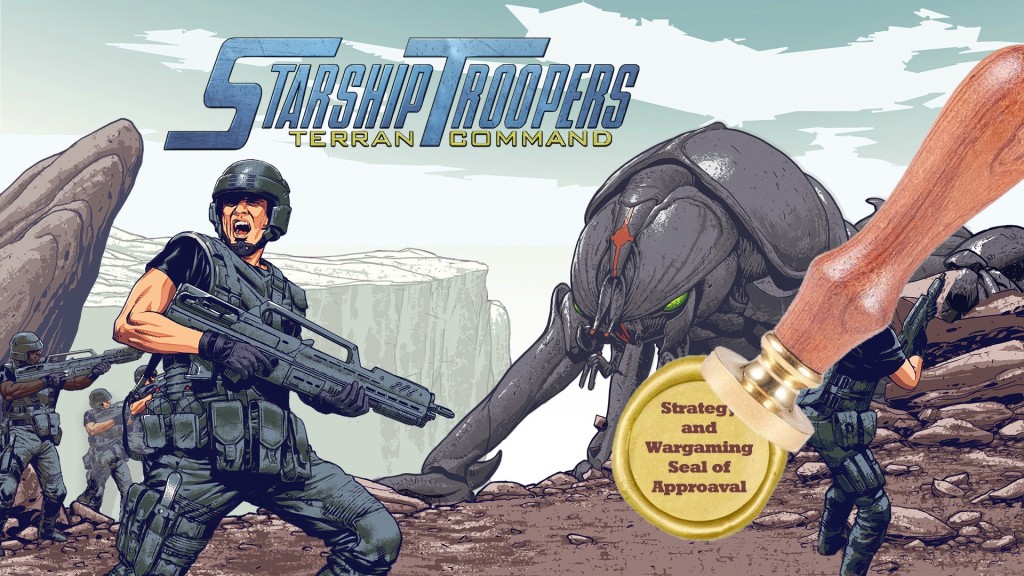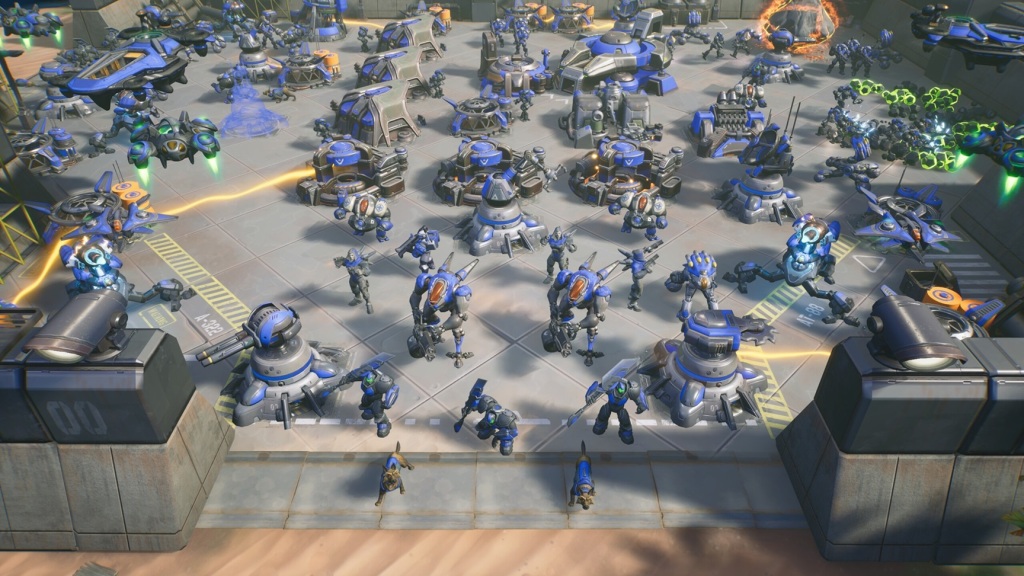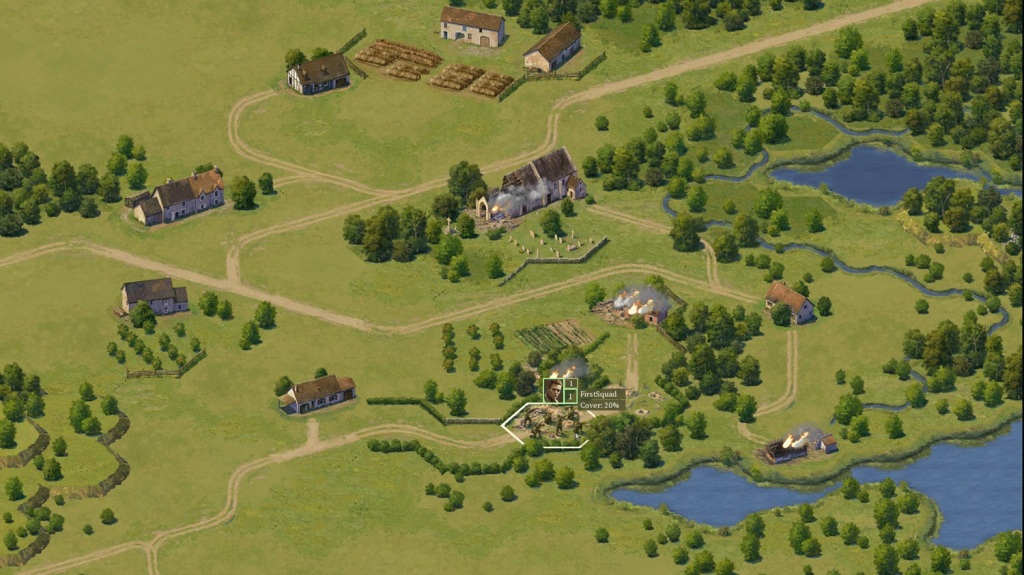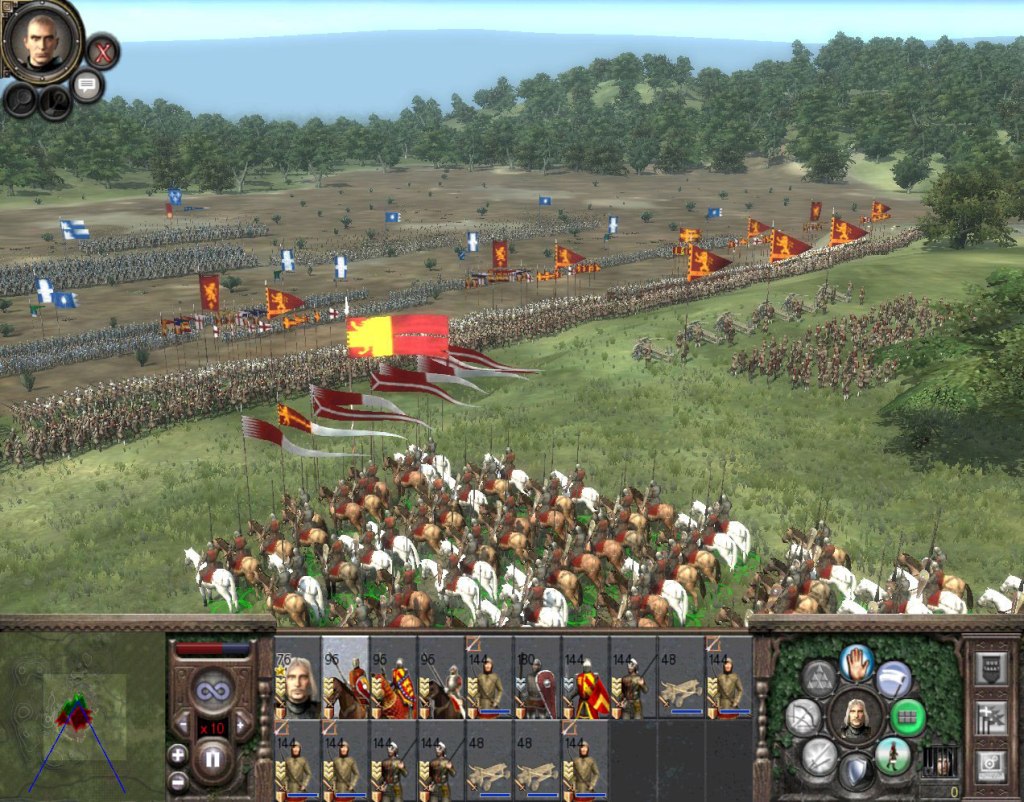The Basics
Starship Troopers: Terran Command is an excellent- if conservative- real-time strategy game and it’s Slitherine’s way of slithering into the mainstream gaming scene. The sheer quality of its presentation, the expansive single-player campaign on display, and a perfect adaptation of the setting to RTS mechanics at such a low price are enough to earn Starship Troopers a commendable recommendation on my end so I can go back and finally finish the campaign. Would you like to know more?
Terran Command is a tactical real-time strategy game set in the Starship Troopers universe, and it drinks heavily from Paul’s Verhoeven 1997 movie adaptation of the novel, and it exudes this influence heavily on its presentation: the propagandistic and fascist’s undertone of the Federation’s communications; the dominant, militaristic society and willing to sacrifice individuals for the greater good; The quashing of dissent and subversive activities. It’s all here, and it’s extremely well done, not trying to be all in your face or trying to make sure you understand that “fascism bad!”. It’s subtle, but it is there. Players will be commanding the iconic Mobile Infantry during their struggle against the bugs on the desert planet of Kwalash.
The Single-Player Campaign and Presentation
To get this out of the day earlier, the game has no multiplayer whatsoever, and while I can see why some might be disappointed by the lack thereof, I can’t fault the devs for this decision. In fact, as someone that only plays single-player titles, it’s a blessing and a rarity to see this amount of dedication to the lone-wolfers amongst us.
As mentioned, you’ll be commanding the Mobile Infantry, shortly after the blunders of Klendathu on the desert planet of Kwalash, after the Federation tagging it as a priority planet to be protected against the arachnid menace. As of right now, I’m a bit further than halfway through the campaign (mainly because I play the same missions several times and try to finish them without losing any units), so in all actuality, I could have finished the campaign more than once if I went straight for it. However, I can confidently say that it’s one of the best single-player campaigns I’ve played in a real-time strategy since either Dawn of War 2 or Starcraft II, and not because it has a very engrossing narrative- sincerely, it doesn’t- but because it manages to capture the essence of the Starship Troopers battlefield and tactical challenges so extremely well. The mission variety is all there, even when the setting has a clear limitation of “go and exterminate big bad bugs”, but the way and locations where these bugs are terminated are what makes it shine so brightly amongst its peers. Instead of opting to place the entirety of the game on the desert surface and putting the player always on the defensive, Terran Command takes players to all kinds of different locations, each offering very specific tactical challenges. Colony scouting and defense are there, but so is taking the fight to the bugs that invaded mining facilities, exploring overrun outposts, and even capturing/rescuing a death-convicted prisoner so he doesn’t miss his televised execution. Not only will you be fighting bugs but also your fellow kind, as the progress of war cannot be hindered by things like “human rights”, “unions” and “work and safety measures”, so there’s also a sequence where some of the Federation’s less-than-happy miners but get their senses knocked back into them, sometimes by using a hail of bullets… or a flamethrower.
The first couple of missions will act more as a guide and introductory scenarios to ease players into the business of cockroach stomping. Similar to other games in the genre, in every other mission or so a new friendly unit gets introduced in a scenario that usually plays to its strengths and weaknesses, teaching you how every unit works. The same thing happens for the enemies, with each new unit you get, the bugs get one that can one-up it, and you get another that also one-ups the bugs! It’s a functional way of slowly introducing more and more complex scenarios and tactical situations. However, the campaign also knows when to slow down, and for every nearly-last stand, stress riddle engagement, there are simpler missions in between that keep the game moving forward without continuously amping up the difficulty. I enjoy this kind of high and low progressions to missions. More often than not, you’ll be strapped for resources and be forced to make do with what Terran Command has available for you to use. This, in turn, means that most of the time you’ll find yourself longing for more resources and wondering how you’re supposed to achieve what’s required of you. One of the things that I enjoy the most is how most of the missions have players taking the initiative instead of fighting this war on the defensive. Better yet, is how most of the missions you’ll be forced to do both, sometimes simultaneous, and that gives way to some of the most memorable moments the game has to offer. Before every mission, context to what’s going to happen is given in the most Starship Troopers fashion imaginable, with an excited narrator going on brave the troopers are, and how they’re doing their part! I don’t want to go into many more details on this topic because I sincerely believe Starship Trooper missions are better experienced by going blind and enjoying the not-so-nice surprises in-store.
The main criticism I can wage against the campaign is that its difficulty slider is more about increasing the bullet sponginess of enemies, instead of doing something smart with it. But then again, what’s smart about a bunch of brainless bugs? The other, less-negative thing but nonetheless worthy of criticism is the constant hive-clearing when some of the missions could do well without them. Hives are an endless source of bugs that need to be cleared by emptying them first, then by sending in a unit into it. This is fine, the problem is that most missions will have you doing this. Early on, you’re warned that sending units into the hive will result in casualties, however, that never happened and I’m not sure why, so there’s that.
To round things off, a couple of words on how the game looks decent enough, but not mind-blowing great. They do a decent enough job of selling the Starship Troopers mood the film made famous. Units -both troopers and bugs- are lifted straight out of the movie props, and the night missions on display exude inspiration from the first troops dropping on Klendathu: the purple-ish hue of the night sky, peppered by muzzle flashes of desperate troopers and the nuclear blue shadows of plasma bugs will make you shout out loud: “It’s an ugly planet! A Bug Planet!”. Animations on the other hand a bit on the rough side- surprisingly, this only happens for the humans: the shooting does not always match up with the recoil of the weapon. The bugs are exquisitely well animated, aside from when they die climbing up the wall. They’ll keep climbing and fall over dead upon reaching the top. I’ve read there are some bugs floating around but other than that one, I’ve yet to encounter another. The fights are visceral and the weapons of the mobile infantry feel like propper guns and not pea-shooters. In fact, I’ll argue they sound even better and pack a much more impressive punch than they do in the movie. Rockets swoosh imposingly, grenades burst with powerful gusts of sand and metal, and shotguns jet the insides of bugs into the ground with a satisfying whiz. Fortunately, the vicious and violent nature of the movie remains intact, with every fight ending up with battlefields sprayed red, green, and yellow from the splattered remains of both friend and foe.
Blending Basic Mechanics and Theme
My reviews are usually framed as being the most mechanically focused ones out there. I’ve always believed a genre and its inherent mechanics should fit the theme it’s trying to recreate. In all honesty, can you imagine a side-scrolling roguelike American Civil War game? Or Romans soldiers firing Javelins? And a World War 2 Moba? Fortunately, The Aristocrats did a great job of adapting the RTS mechanics to fit the theme and feel of the movie’s bug-mangling action. So, how did they do that? The secret to defeating the bugs is to maximize the firepower available against them. Well, in most RTS players are allowed (and encouraged) to clump units together that can fire between one another with impunity and extremely effective results. No blobs of doom. Not here. A strict line of sight system was developed that prevents units from firing across/between/through each other. There are three types of firing capabilities: green, meaning unobstructed and the full firepower of that unit is brought to bear; yellow, partially obstructed only allows for a couple of units to shoot; and red, totally obstructed, the unit won’t fire. Is this system totally flawless? Of course not, sometimes units might appear to be on the green and for some reason, they’ll show up yellow and that can be infuriating. Take a look at the image below, on the left and right, the firing status is green, and on the middle, with a seemingly clear line of fire, the unit’s firing status is yellow. Move it a couple of inches to the right and goes full green.
This might sound like nitpicking but it happens often enough that you’ll be always worrying about it, this problem is especially exacerbated when you’re manning the walls of a settlement and your troops will inexplicably refuse to fire if they have the smallest object. However, despite its flaws, this system is what makes Starship Troopers: Terran Command so challenging and tactically flavourful in the first place. This is not a game about well place shots and tactical subtleties. It’s all about bringing a wall of lead to mow down the enemy herd. It’s essentially 19th-century tactics with machine guns, rocket launchers, and mechs. The line of sight system forces you to plan your troop locations ahead of the engagement because one step too far in the wrong direction can spell the end not only for that unit but for the entire force. You see, if the bugs manage to get close enough that they can start to melee your troops, chances are you have lost the fight, because no matter how many bullets you can spit at close range, humans are still fragile bags of flesh and viscera held together by bones and muscles, standing little to no chance against the hardened exoskeletons of the arachnids. Turning tail and running is seldom an option because the multi-legged creeps will always catch up and cut down the poor sods. Also, Kiting is out of the question for the same aforementioned reasons. Human units are fragile, is what I’m saying.
So, maximizing firepower, keeping your distance, and planning locations of the fights before they happen. To help you do this is a really simple, but fairly important terrain system. Instead of granting you flat a percentage bonus damage or range. The different levels of height allow units to fire over each other, and it’s the only instance that you can create overlapping fire. The limited fields of fire mechanics work great in tandem with the terrain system and it’s one of the best combos I’ve seen in a while. There was clearly a lot of thought put into it: terrain elevations are all over the place and it’s up for you to identify and take advantage of them. However, it would be cool to have units garrison the buildings, firing from windows and roofs.
This thematic adaptation extends to another area of the game: unit building and reinforcements. Let’s get into it.
“Base Building” and Units
Base building in ST: TC is the game simpler affair: plop buildings in pre-determined locations to access new units. Each building costs war support and you can lay down one of each. Units, in turn, cost resources. You go about getting these in every mission by completing objectives for the first, and gathering the latter on the map. In turn, this gives you a very large and substantial motive to complete every side mission objective, allowing you to reinforce your on-the-field presence with more troops.
Say you have the requisite buildings set up and enough resources, now it is a matter of clicking the unit you want to be deployed on the field and they’ll arrive via transport ship. Speaking of which, you have three of those and they’re used to bring units into the field, reinforce depleted squads, and lift off units you no longer need. After each use, they’ll go on a short cooldown. Curiously enough, you are able to permanently reinforce fighting squads provided at least one of the men and women in the fight are able to make it to the pre-established spawn point. This curious design decision has several explanations for it: since there’s no persistent campaign progression of your units, every mission they start as if they have just come out of boot camp. Progressively they accrue experience and given they slay enough bugs they’ll become veterans. This process can take quite a few engagements and you’re sure to lose some of those brave marines in the process, so arriving at the end of a long fight and having a quarter of a squad of veterans wouldn’t be much fun. I think this was the rationale behind this choice. Veterancy will have a big impact on the way you conduct your operations. See, veteran units gain access to more active skills (they have one by default) and these can range from being indispensable to… “well it’s better than nothing”. Line infantry starts with the ability to throw a grenade every 30 seconds or so (one must suppose the incompetency that led to Kelendatuh isn’t entirely rooted out of the Federation) but after reaching the veteran status you’re able to pick between a german style Geballte Ladung and a wall of underslung shotgun blasts. Engineers can opt to either shoot a powerful stream of plasma or set up a demolition charge. The Tactical Officer can choose to increase the defensive or offensive capabilities of the forces under his command. The MK2 troopers will either launch flak grenades or use a ripper blast. You get the gist of it. These active skills are a welcoming addition to the gameplay and act almost like a force multiplier or, if push comes to shove, as a way to get rid of sticky situations, and will give you an incentive to keep your veteran units alive (by reinforcing them constantly). They won’t change radically the way you go into encounters and I’ll argue they won’t annoy the less micromanagement-inclined amongst you, especially because, since most of the battle movement happens before the battles take place, these activatable skills give you something to think about and do while the fighting marines are wailing down on the bugs.
The game’s asymmetric nature would, inevitably, lead to an interesting selection of units, both from the Humans and the bugs. These disparate ways of waging warfare open the field to a lot of different tactical avenues rarely seen in other similar games of the genre. It’s one thing to fight evil nazis wielding MG42s by using grenades and bullets, and it’s a whole different affair defeating an endless wave of fangs and teeth. The Federation units will comprise mostly of your usual arsenal of gun-toting servicemen and women, flamethrowers (what’s a good bug-killing game without the goo’old flame-spitter?), snipers, rocket launchers, officers, and eventually big stompy marauders. Were the maps a bit larger and I would subtract love points for not including tracked vehicles, but alas. The bugs units won’t have as much variety but they still cover all the bases. The Warriors are the basic arachnid swarmer, later the game will introduce the Tigers, a stripped and meatier variant; Spitter bugs are basic – but devastating- ranged melee (better tackled by having a specialist sniper unit accompanying your grunts). The scarily effective Tanker Bugs can be a pain in the ass to take down, but in classical movie fashion, grenades are highly effective at stunning them.
There are also Drones, Scorpions, Plasma Bugs, Plasma Grenadiers, and of course, the annoying head-slicing Hoppers. Each and every unit is introduced gradually into the campaign and instead of simpling one-upping one another, the game does a great job of mixing them up across several missions. For example, Hoppers might be excessively present in the first couple of missions but will be absent for a number of other ones, the Tanker Bugs will feature heavily on some and be replaced by Plasma Bugs for others. This, in turn, has the advantage of making sure the enemies you’re fighting won’t predictable (and consequently boring) across the game’s twenty-something campaign. In fact, the only unit guaranteed to be present is the ubiquitous Warrior Arachnid, but I wouldn’t have it any other way. The gradual introduction of both enemy and friendly elements serves to highly their strengths and unavoidable weakness, how to better take advantage of them (in case they are friendly), and how to defeat them (in case they’re not).
One of the things I want to mention before wrapping up this already way too long review is the construction of turrets by engineers. A nice, and necessary, touch is the inclusion of buildable turrets by the engineering teams. Not only are turrets one of the iconic images of the 1997 movie, but they’re also highly effective at mowing down rows of nasty crawlies. Terran Command gives players the opportunity to build machinegun emplacements, rockets, and grenade launchers. This is useful when you have to move your troops outside your bases but still have to keep the bugs at bay. Anyway, let’s end this.
Final Score
Starship Troopers: Terran Command is a videogame that screams homage and exudes reverence for the films of the franchise. A stellar presentation in combination with an expansive campaign that’s going to last you a good dozen hours before you’re done with it, allied with a fantastic friendy and enemy unit variety that is both movie-accurate and interesting to play with, plus the tactical conundrums present that are sure to stir some of your brain cells to make Starship Troopers an obvious purchase. That’s not to speak about the fact that the games cost some meager 25€. So, if you’re either a fan of the franchise or want to play one of the best real-time strategy campaigns since the release of the first Company of Heroes and Starcraft II, Starship Troopers don’t fret. Despite some of the bugs and lighter criticism, I can’t help myself and must award Terran Command a Strategy and Wargaming Golden Seal of Approval. Starship Troopers: Terran Comand is what happens when the theme meets the mechanics with exquisite care. You made the Federation proud!
Now go and make me some DLC!
Follow Strategy and Wargaming Socials
Strategy and Wargaming needs you to follow its socials. Are we the best strategy gaming website around? I would say so. Heck, what other options do you have? The Wargamer? Please.
So why not give us a follow on the cesspool that is Twitter, or join the 1000 other geriatric patients on Facebook? Or subscribe down below? Or maybe do everything? I don’t care, I’m not your grandmother.
If you enjoyed the article, consider buying me a coffee!
I’ve been running Strategy and Wargaming at my own expense since 2017, with only the ad revenue to cover the hosting, with everything else being done by me. So, if you’re an avid reader, you can afford it, and want to support the website, please consider Buying Me a Coffee by clicking this link, for as low as one euro! If you do, just know that you’re helping out a lot and contributing so that Strategy and Wargaming can continue growing!

















Leave a comment